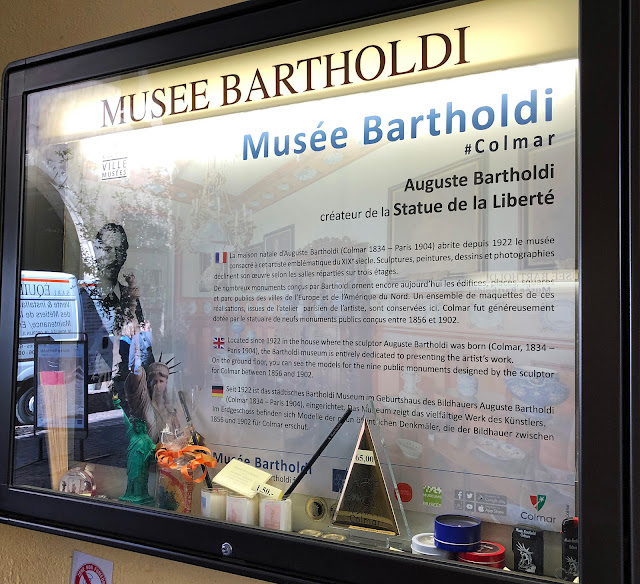This trip abroad, in the autumn of 2019, was my last trip to across the pond. I have averaged two trips a year to different parts of Europe since my retirement in 2012. As I write in spring 2021 (exactly two years after my penultimate pre-pandemic journey to northern Spain) I see very little possibility of a return until spring 2022. This saddens me, "more than I'll show, more than you'll ever know."
Having said that, it was a glorious adventure, beginning briefly in Strasbourg (see my most recent post), primarily make a day trip to Colmar, which I missed on my first Strasbourg visit in 2014. I journeyed next to Lyon (very nice), then Marseille (wonderful!) and spent the rest of the time in Provence, staying in Arles and Avignon and day-tripping extensively from those two places. The weather was accommodating and the entire experience filled me with the joy of travel abroad.
I travel solo (am a solivigant, to use a highbrow term for travel on ones own) because I'm a selfish, often grumpy old man who treasures every moment of a travel adventure.
While I spent only three or four hours in Colmar, I was delighted with the picture-postcard-perfect town from the moment I stepped off the train. It has been called a tiny Strasbourg, and I'd agree with that, but Strasbourg sprawls beyond its picturesque old town, including the ultramodern European Union section at the edge of the city.
In compact Colmar I'd venture to say that every neighborhood I visited boasts at least a little old town beauty. In fact it's been said that Colmar was the model for Disney's Beauty and the Beast! And who am I to disagree?
My only disappointing structure was very near the rail station, and even it was redeemed, for me at least, by the graffiti on it:
Just beyond that non-landmark is the edge of the old town - easy to spot, easy on the eyes:
Just about every-place Disney looks to me slightly phony, a tad too sweet. The rusticity of Colmar is never that, it's the real article, not the Epcot version.
Okay, sometimes it comes close, but even the brightest, prettiest buildings are weighted in reality, feel their age, in the best way possible. One of the oldest buildings is the Pfister House, dating from 1435.
Ages well, yes?
In a place that is centered on tourism, there are of course tons of tourist shops,
but I'll take those any day - and good chocolate is good chocolate, now matter how dressed up.
Before I take you to the very center of tourism, let me show you a place of interest that's less than 500 years old. The Bartholdi Museum celebrates the man who designed our Statue of Liberty:
It's the focus of the museum, and you will get your fill of it, in posters such as this one:
In many models:
even one of Lady Liberty's left ear!
There is little question that Bartholdi is most famous from Miss Liberty, especially on the western side of the great pond, but he created other work as well, including the Lion of Belforte,
Rouget de Lisle, who wrote the Marseillaise
And to symbolize the alliance of the US and France, Washington and Lafayette:
It's a diversion, but a worthwhile half hour or so, especially I suppose, for an American particularly during Trump's reign of terror, when frequently Lady Liberty was pictured as imperiled by MAGA-in-chief in political cartoons. I was never so relieved to be out of the US!
On then toward the center, past a lovely square, viewed through an arch, brightly,
via old houses in which half-timbering abounds
through another lovely square,
to Petite Venise, "Little Venice" - tourist central, and for good reason!
Gondolas, swans, eateries...and in the distance you can see "Fanny's Bridge, named not for the young woman of Marseilles, a central figure in Marcel Pagnol's tales, but the the near constant "fannies" packed on the bridge, looking over the waterway.
Below are a few views from Fanny's Bridge:
And from the other side of the bridge, another pretty view, also the point at which tourists board the gondolas:
Petit Venise, a real beauty of a spot. From there I wandered back toward the rail station, making one important stop on the way. In the Unter den Linden Museum the center of attention is Matthias Grunewald's Isenheim Altarpiece, painted between 1512 and 1516. His largest work, it is also thought by art historians to be his masterpiece.
Even if you don't fancy medieval art, it is stunning. And intricate - below, a model of the altarpiece shows that the above arrangement is not the only view:
After that experience I was almost finished with my day in Colmar...but a man has to eat, and did I ever, Alsatian-style, with a choucroute!
More very soon, hope you liked it - next posts from lovely Lyon!























No comments:
Post a Comment